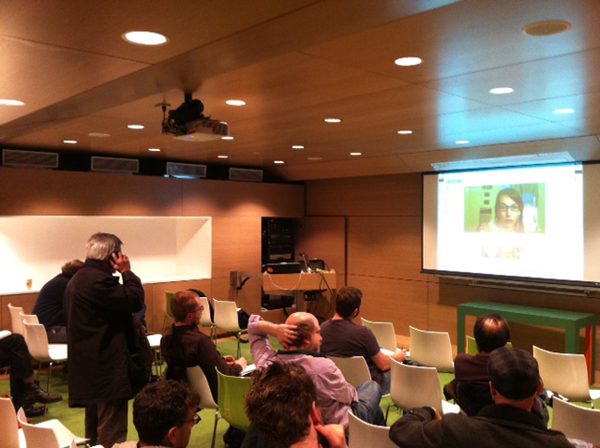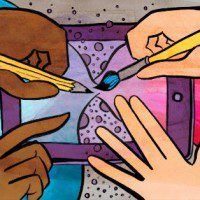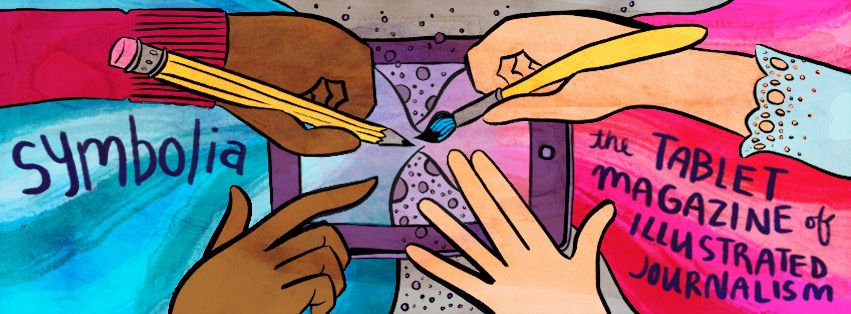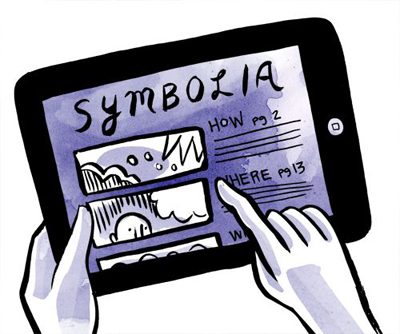The New York Comics & Picture-Story Symposium is a weekly forum for discussing the tradition and future of text/image work. Open to the public, it meets Monday nights 7-9 pm EST in New York City. Presentations vary weekly and include everything from historical topics and technical demonstrations to creators presenting their work. Check out upcoming meetings here.
Erin Polgreen, founder and creator of the new tablet magazine of illustrated journalism, Symbolia, gave this week’s presentation. Polgreen was our first virtual Symposium presenter, web-conferencing in from Chicago to a room full of New Yorkers who braved snow to hear her speak about graphic journalism and the medium of digital comics.

Skyping In
The webinar presentation began predictably with technical difficulties, but turned into a lively and interactive session, thanks to Polgreen’s jam-packed presentation and grace under pressure. The audience could see and hear her, but she could neither see nor hear the audience. As a stopgap solution, the meeting proceeded with this limitation and a cell phone was passed around so that audience members could interact and ask questions.
Overview of Symbolia
Polgreen started her presentation with an overview about what Symbolia is, how it began, and what it aims to do. Symbolia is a tablet magazine that seeks to explore journalistic storytelling in comics form. Each issue centers around a theme. The most recent issue examined the theme of “belonging” and featured stories about immigration. They currently put out an issue every other month that is accessible on iPads or in PDF form and hope to publish more frequently in the future. Symbolia for Android is under development and will be available in the coming months.
The Medium of Digital Comics
Symbolia experiments with combining illustration, text, video, and audio to offer readers a sensory entry point into stories. Exploring multi-modal storytelling and engaging readers is central to Symbolia’s mission and vision. “Interactivity,” Polgreen suggested, “heightens the way readers read and experience stories.” She quoted cartoonist and graphic novelist Sarah Glidden, who proposes that comics can “trick readers into reading something they wouldn’t normally read.”
Wendy MacNaughton’s illustrated piece on public libraries for The Rumpus is another example of a comics reportage mentioned by Polgreen.
With Symbolia, Polgreen hopes to promote graphic journalism as an emerging trend that challenges the boundaries of how we read and tell stories.
The Audience
Symbolia is unique in that it has potential cross-market appeal for comics readers, technophiles, and journalists alike. They are most interested in stories that are global and cross-cultural. Given this, it is not suprising that 45 percent of Symbolia’s audience is international, with the strongest readership (outside of the U.S.) in India, the Netherlands, and Germany. It currently has an audience of about 15,000 readers, 800 of whom are subscribers. They had a soft launch on Facebook in late 2012 and their readership is steadily growing.
The Business Side
Polgreen also spoke at length about how Symbolia is funded. She, along with Joyce Rice, Symbolia’s Creative Director, are not only attempting to grow the visibility and reach of digital comics journalism, they are trying to create a sustainable business model for digital publications of this kind.
Symbolia was started with seed funding and grants. Subscriptions now comprise a portion of their revenue. Readers can purchase issues individually at the market rate of $2.99 or six issues for $11.99. When Symbolia hits 1,500 subscribers, they will reach their baseline profit margin. At 3,000 subscribers, Symbolia will become a sustainable venture. With her experience on the business side of publishing and journalism, Polgreen is wary of relying too much on any one revenue stream and actively explores different models of sponsorship to underwrite salaries. They also accept advertising in a way that works with the publication format and content.
Process and Work Flow
Symbolia has developed a five-step checklist for how to get a story from “pitch to publish.” First, they consider what the story is, giving special thought to the medium, the form it will take and the tools that will be used. Next comes the “reporting and synthesizing” phase, where they pair journalists and cartoonists to investigate the story.
Then, they turn their attention to the “scripting and sketching” process that involves a detailed thumbnail review process. This is where the process diverges from traditional print journalism. Because there are more layers to this work flow, the check-in process is key to making sure that the components of the story, whether visual or audio, are all aligned to give the reader an intuitive reading experience.
In the next phase, the editors take a cue from traditional journalism and focus on fact-checking and editing. A considerable amount of thought and design goes into the creation of each issue. At the same time, they are also figuring out what works best as they go along. An important part of this process is user-testing. Polgreen and Rice are concerned with “finding ways to tell deeper stories,” so they pay close attention to how readers experience the different layers of each piece. Lastly, they refine, publish, and promote.

Pitching to Symbolia
Symbolia welcomes pitches! Polgreen and Rice have a particular interest in promoting women journalists and comic artists and strive for 50 percent gender parity in each issue. Symbolia prides itself on publishing stories that are well-researched and have a strong sense of narrative. The art should be representational and traceable to a specific location or event.
Polgreen said, “We encourage people to report from the places they are, but we don’t require it.” Symbolia is less interested in stories on “breaking news or cold-facts reporting, ” which is not as effective for the tone of the publication. They are accepting pitches for their upcoming issue with the theme of “defense.” Check out their pitch page for more information.
Symposium Wrap-up
Following Polgreen’s virtual appearance at the Symposium, the audience members stayed behind to discuss summer plans for the Symposium and then branched off into a discussion about visual journalism, the advantages and disadvantages of digital publications, the question of sustainability, and the future of comics journalism. We brought up past presentations and examples of possible predecessors, including illustrator Robert Weaver, who was one of the pioneers of visual journalism.
Though there were some technical hiccups, it turned out to be an energizing and thought-provoking presentation. The group is also excited about the prospect of holding more webinar presentations and making the Symposium accessible to a larger comics community.
***
CONNIE SUN is an Asian-American cartoonist from California, currently living in New York City. She works in higher education and draws a daily web comic strip at conniewonnie.com, Monday through Friday. You can follow her on Twitter.






